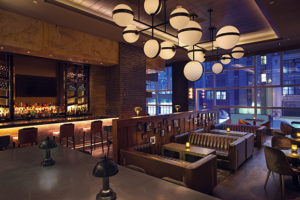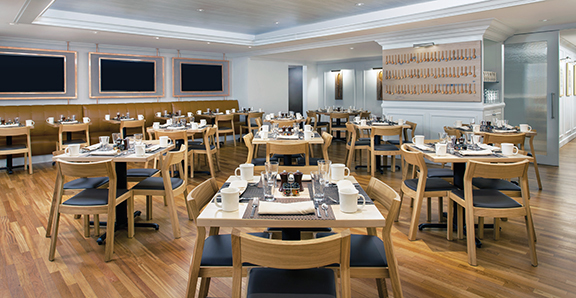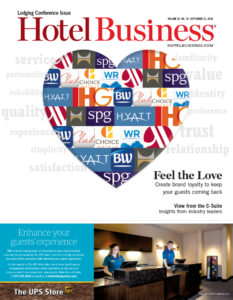When Westin New York at Times Square, an 873-room luxury hotel, completed a $39-million, multiphase renovation, one could say the addition of its new culinary concept, Foundry Kitchen & Bar, was the cherry on top of the Big Apple’s pie.
F&B at the hotel is separate and located on two floors: The Foundry Kitchen is on the ground floor, while the Foundry Bar is on the mezzanine. Just outside the bar area, the lobby was redone as part of the renovation, as was the Empire Suite on the hotel’s 45th floor. Tishman owns the hotel, which is operated by Starwood.
By definition, a foundry is an establishment that is used to make castings of molten metal—and those are just the kinds of items Foundry Kitchen has adorning its walls. They tell the story of what its creators had in mind for its design and culinary concept. Ron Kollar, chief design officer for Tishman, discovered the foundry items that include metal pulleys, wheels and hinges, at flea markets across upstate New York. “The objects have oxidized with use over time, resulting in a beautiful weathered patina that adds a rich textural backdrop to the space,” he said.
In its former iteration, the Kitchen was a Shula’s Steakhouse franchise with dark cherry-wood walls, tables and furnishings. Through Starwood’s analysis system, the Westin team figured out that most of the people at Shula’s Steakhouse were not guests of the hotel, but instead, pre-theater diners who wanted to enjoy a bite before the big show. “We realized our guests aren’t spending their money here,” said Robert Snyder, president, Tishman.
To get guests spending at Westin’s F&B venue, they swapped Shula’s for the Foundry Kitchen and decided to serve an earlier breakfast menu instead. To brighten up the window-less room, Kollar and the ICRAVE design team used white-tiled walls and light-wood trim and furniture. Plus, the use of copper pots and pans gives the illusion of daylight in the room, which has only 9-ft. ceilings. Although the Kitchen does not serve dinner, guests can take a quick walk upstairs to the Foundry Bar for a later meal, because it is open until nearly midnight. Both areas can serve up to 90 people at a time. To tie the two areas together, the design team incorporated a private stairwell and a large arrow connecting the Kitchen and Bar.
With views of 8th Ave., the bar/lounge was created as a place where both guests and locals could get away from the fast pace of Times Square. When designing the menu, the team thought of foods people could eat at any time; smaller meals such as sliders, pizza and quesadillas. “The menu is kind of a broad selection,” said Snyder; “We are no different than any other hotel in that we make more money at our bar than anywhere else.” To accommodate the bar crowd further, Snyder introduced four rotating beers to always be on tap; Brooklyn Lager is among the choices.
 A chandelier hangs in the bar, captivating people from the street below, according to Kollar and Snyder. It is a large structure measuring 25 x 8 ft., and is comprised of spheres. “The team installed this lighting fixture above the room and it’s like a beacon from the outside. As people walk down 8th Ave., they see this amazing fixture and think, ‘What’s that up there—what’s going on in that space?’” Kollar said. He called the bar a collection of things rather than a design statement. “It has an eclecticism about it.”
A chandelier hangs in the bar, captivating people from the street below, according to Kollar and Snyder. It is a large structure measuring 25 x 8 ft., and is comprised of spheres. “The team installed this lighting fixture above the room and it’s like a beacon from the outside. As people walk down 8th Ave., they see this amazing fixture and think, ‘What’s that up there—what’s going on in that space?’” Kollar said. He called the bar a collection of things rather than a design statement. “It has an eclecticism about it.”
Another addition to the bar area is technology. They installed cell phone charging stations, large TVs and even iPads in the lobby. “The servers will deliver your drink based on the iPad you ordered from,” said Snyder.
According to Snyder, hoteliers are opting to add their bars as close to the lobby and front desk as possible now. “Typically, what hotels are doing is putting the bar and lobby somewhere approximate to the front desk. It’s nothing new. We talked a lot about doing that here,” he said. “A lot of the decisions around this concept and design were dictated by the design of the building. As much as we would have loved to build a bar at the concierge desk, the noise of the bar would have been too much”
Also included in the renovation was the Empire Suite, an 1,800-sq.-ft. super-room located on the 45th floor featuring two bathrooms, a bedroom, living room and kitchenette. The suite features views of Manhattan and even a glass writing wall for meetings. The lobby was also redone with both natural and urban elements in its design. The epicenter of the room is a pair of 1,000-lb. tables made from an Indonesian teak tree, according to Snyder.
“This was a lot of money to invest,” Snyder said. “Compared with doing a room renovation, where you have the opportunity to build a model room, you can’t do that with a bar. We planned this out for years. We are really happy with how it came out.”
According to Snyder, the most difficult part was getting the work done in a timely manner. “The New York City market enjoys particularly high levels of occupancy and the Times Square market is the most robust with the heaviest occupancy submarket in the city,” he commented. “Getting work done in the hotel is difficult because it’s always busy.” He explained the hotel had gone through a makeover more than five years ago but this renovation was meant to concentrate on the hotel from an F&B perspective.
“You need to take every market differently. Many of the reasons people come to visit New York is the restaurant scene. The New York restaurant scene is the most varied and well-known in the U.S. and it competes on a global platform,” Snyder said. HB


